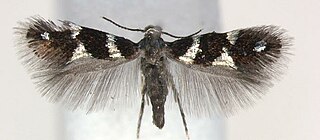
The Heliozelidae, commonly known as shield-bearer moths, are a family of small, day flying monotrysian moths distributed worldwide. The larvae of most heliozelid species are leaf miners who cut distinctive shield-shaped cases from the surface of the host leaf, hence the common name. Some species are considered pests of commercial crops such as grapevines, cranberries, and walnuts. The taxonomy of this family is poorly understood.
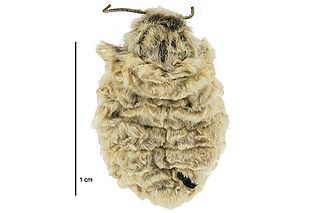
Metacrias is a genus of moths in the family Erebidae. All species are endemic to New Zealand.

Barea codrella, the barea moth, is a moth of the family Oecophoridae. It is found in Australia, more specifically Tasmania, New South Wales and Victoria and South Australia. It is also an adventive species in New Zealand.
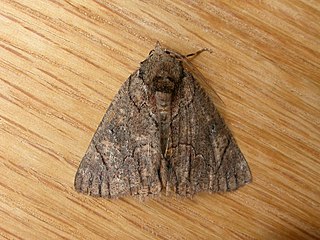
Heliomystis is a monotypic moth genus in the family Geometridae. Its only species, Heliomystis electrica, the electric moth, is found in the southern half of Australia. Both the genus and species were first described by Edward Meyrick in 1888.

Scopulini is a tribe of the geometer moth family (Geometridae), with about 900 species in seven genera. The tribe was described by Philogène Auguste Joseph Duponchel in 1845.
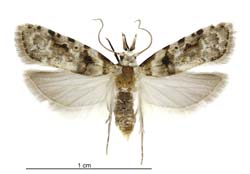
Coscinoptycha improbana, the Australian guava moth, is a moth of the family Carposinidae and only member of the genus Coscinoptycha. It is native to Australia, where it is found from Eungella in Queensland down through New South Wales, Victoria and Tasmania. It also occurs on Norfolk Island and has been recorded from New Zealand since 1997. The presence of this species has also been detected in New Caledonia in 2012.
Heliozela prodela is a moth of the Heliozelidae family. It was described by Edward Meyrick in 1897. It is found in New South Wales, Queensland and Tasmania.
Pseliastis spectropa is a species of moth of the family Heliozelidae, described by Edward Meyrick in 1897. It is endemic to Tasmania, Australia.
Pseliastis trizona is a species of moth in the family Heliozelidae, described by Edward Meyrick in 1897. It is endemic to Tasmania, Australia.

Pseliastis xanthodisca is a species of moth in the family Heliozelidae, described by Edward Meyrick in 1897. It is endemic to Tasmania, Australia.
Plesiozela is genus of moths in the family Incurvariidae. It was described by Ole Karsholt and Niels P. Kristensen in 2003 and initially placed in the family Heliozelidae.
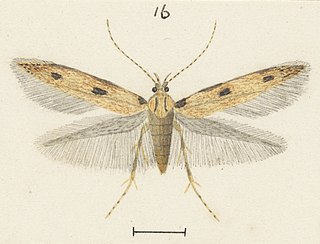
Labdia anarithma is a moth of the family Cosmopterigidae. It was described by Edward Meyrick in 1888. It is found in New Zealand and throughout Australia. Adults are on the wing from December to March and are day flying. They have been collected by sweeping bracken fern.
Chloroclystis catastreptes, the green and brown carpet, is a moth in the family Geometridae. It was described by Edward Meyrick in 1891. It is found in Australia.
Ascalenia semnostola is a moth in the family Cosmopterigidae. It was described by Edward Meyrick in 1897. It was described from the Australian state of New South Wales, but has also been recorded from South Africa.

Haemodorum is a genus of herbs in the family Haemodoraceae, first described as a genus in 1798 by James Edward Smiith. The genus is native to New Guinea and Australia. The type species is Haemodorum corymbosum Vahl, first described by Martin Vahl in 1805.
Elachista demogenes is a moth in the family Elachistidae. It was described by Edward Meyrick in 1897. It is found in Australia, where it has been recorded from South Australia.
Notodryas aeria is a moth in the family Epermeniidae. It was described by Edward Meyrick in 1897. It is found in Australia, where it has been recorded from the Australian Capital Territory, New South Wales, Queensland, Tasmania and Victoria.
Ardozyga stratifera, the striped ardozyga moth, is a species of moth in the family Gelechiidae. It was described by Edward Meyrick in 1904. It is found in Australia, where it has been recorded from Queensland, New South Wales, Victoria, Tasmania, South Australia and Western Australia.
Heosphora is a genus of moths in the family Pyralidae. The genus was first described by Edward Meyrick in 1882. The type species is Anerastia psamathella Meyrick, 1879, designated as such by George Hampson in 1901. All Heosphora species are found in Australia.

Opsitycha squalidella is a moth of the family Oecophoridae. It was described by Edward Meyrick in 1884. This species is native to Australia and is likely adventive to New Zealand.










